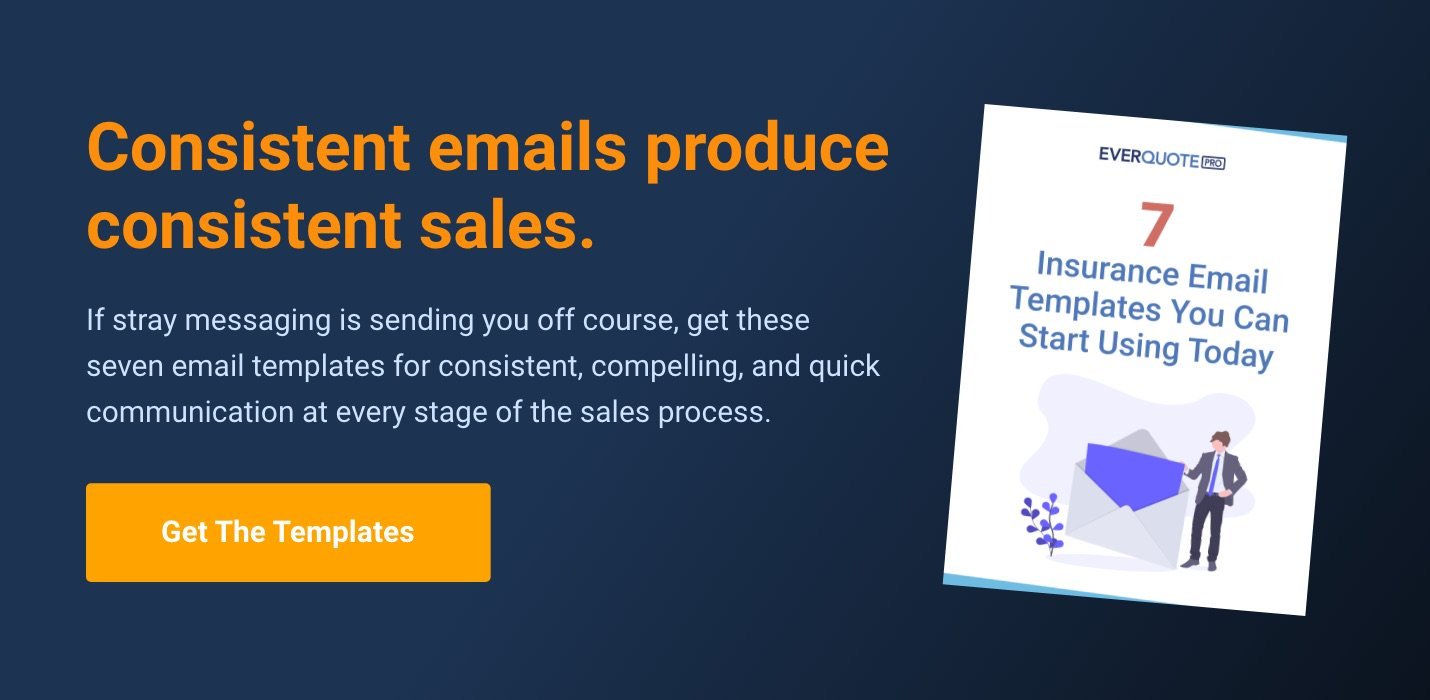- Home»
- EverQuote Pro Blog»
- Eureka! Doing Insurance Email Marketing Right Will Help You Strike Gold
Eureka! Doing Insurance Email Marketing Right Will Help You Strike Gold

When it comes to insurance email marketing, we’ve got good news and bad news.
The bad news first: most agents either don’t email prospects at all, or they don’t send the right message at the right time.
But the good news is really good news: It’s easy to start email marketing if you aren’t doing it currently, or fix an email system that isn’t working well.
Email Marketing For Insurance Agents: What You Need To Know
If you’ve ever wondered, “Am I doing the right thing when it comes to follow-up strategy with email?” then you’re way ahead of many agents—a good number of whom aren’t doing any email marketing at all. Because email marketing is such a huge beast, we’re going to focus on a few best practices, which we’re certain will help change the way you bind policies.
Part 1: Understanding Your Customer Base.
Email marketing isn’t much different than any other marketing or sales technique when it comes down to it. To be successful in insurance email marketing, you have to put yourself in the shoes of your potential customers and speak to directly to them.
So the golden rule is: “Don’t email people who won’t write business with you.” The key to following that rule lies in segmentation—making sure you’re saying the right things to the right audience. Depending on who you’re talking to, you’ll inevitably focus on different things. To do that rule, then, you need to first be certain your audience and customer base is well defined, then make sure your emails focus on the correct things to say. Keep in mind that what’s crucial here is identifying who your prospects are so you can focus on things that matter to them.
When emailing premium consumers, focus on level of coverage and ease of claims.
Agents who target premium consumers—those who are lower-risk, have good and excellent credit scores, and own their homes and multiple cars—shouldn’t use email marketing language that solely emphasizes “saving a bunch of money.” For these consumers, savings is not the focus; it is service and getting the right level of coverage for all the things going on in their lives.
Next in level of importance is ease of claims. Your emails should emphasize your agency’s support when something goes wrong. For example: “As your local agent and the owner of this company, if anything goes wrong, I will personally put in the claim for you so you don’t have to do any work.” It’s succinct and speaks to a pain point of this customer, which is removing the burden of knowing where their insurance coverage will come from.
When emailing high-risk consumers, focus on product offerings and price.
If you’re the owner of an agency that targets price sensitive, high-risk consumers—those with multiple violations, poor credit, etc.—your email marketing should focus on the products that will best cover them. These consumers already know getting coverage may be a challenge, so they’re most concerned about whether or not you have a product that can benefit them. Next in importance? A reasonable price. Once they know they can get coverage somewhere, the next question is always about price. Obviously, this perspective is very different than the perspective of the premium consumer.
When emailing consumers “in the middle,” focus on building a relationship.
Most agents will be writing a mix of some premium consumers and some standard, or what we refer to as “in the middle” consumers. These standard consumers are not as high risk as the previous group. We’ve found that what matters to them is a relationship built on ease of claims, pricing, and convenience combined. If you can speak to all three of these concepts in your email marketing, you’ll have a good chance of at least catching the eye of these middle-ground consumers.
| In review, remember that segmentation is a critical part of email marketing. Your carrier and your products, as well as your ideal audience, should play into what your emails say, so make sure you’re confident about your audience and your message before you hit send on any email. |
Part 2: The Proper Cadence For Email Marketing
After you know what to say in your email marketing and how to say it, you need to understand when and how often to send emails. Because this idea is so critical to success, we leveraged a recent study which analyzed millions of data points to determine the proper cadence for email marketing. Here’s what the results uncovered:
The term cadence refers to when and how often agents contact potential leads. If you buy internet leads, 99% of agents make phone calls. They might call multiple times on the first day, the first week, and through the month (and sometimes even beyond 30-60 days). But while the protocol for calling is well known, what you may not know is how often you should be emailing prospects as well. Emailing must be part of your playbook because:
- Sending emails can increase your contact rate by 16 percent.
- 60 percent of leads will never receive an email (because 60 percent of agents never email their prospects!).
Here's a winning formula, backed by research:
Send five emails—no more—over a month span. After five emails, the odds of contacting a lead actually go down.
| Many agencies neglect this simple step, even though the Velocify study found that the combined power of those five emails could raise total conversions by 53 percent. However, going above the magic number of five can actually hurt you, because you’re then perceived as a spammer. |
To see the breakdown of exactly when to send out these five emails, download our free white paper: Binding Inbound Leads.
Email marketing for insurance agents is an underutilized tool. In fact, we’d even go so far as to say it could be a potential game-changer for your agency—if you do it the right way. By harnessing the power of segmentation and making sure your insurance email marketing cadence follows best practices, you have the potential to increase your conversions by upwards of 53 percent and really strike gold with an effective insurance email marketing strategy.
Want to know more? Download the free eBook to learn even more practical steps you can take to bind leads using email marketing.
Unlock predictable growth with EverQuote.
Our representatives are standing by to help you succeed.
Call 844-707-8800
Weekdays, 9AM-5PM (ET)
Call 844-707-8800
Weekdays, 9AM-5PM (ET)
Accelerate your growth.
Complete the form below or just call 844-707-8800 to learn how we can help you achieve your goals.
By clicking "Get Started", I consent by electronic signature to being contacted by EverQuote, including by automatic telephone dialing and/or an artificial or prerecorded voice (including SMS and MMS - charges may apply), regarding EverQuote for Agents, even if my phone number is listed on a Do Not Call Registry. I also understand that my agreement to be contacted is not a condition of purchasing any goods or services, and that I may call (844) 707-8800 to speak with someone about EverQuote for Agents.
By clicking "Get Started", I affirm that I have read and agree to this website’s Privacy Policy and Terms of Use, including the arbitration provision and the E-SIGN Consent.
* Mandatory fields
 Product Overview
Product Overview Blog
Blog FAQs
FAQs Webinars
Webinars eBooks & Resources
eBooks & Resources